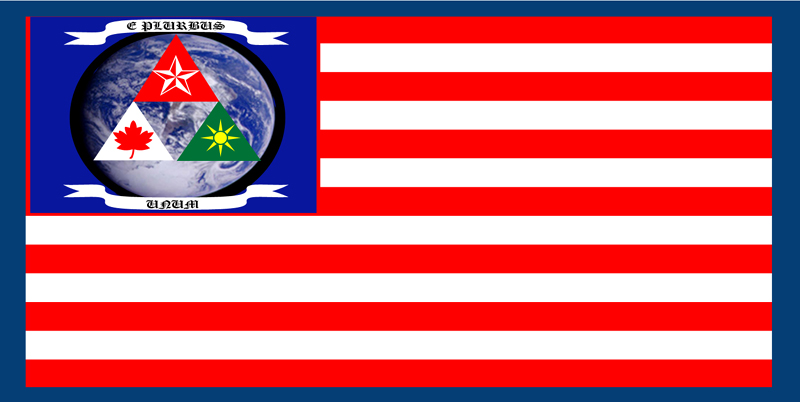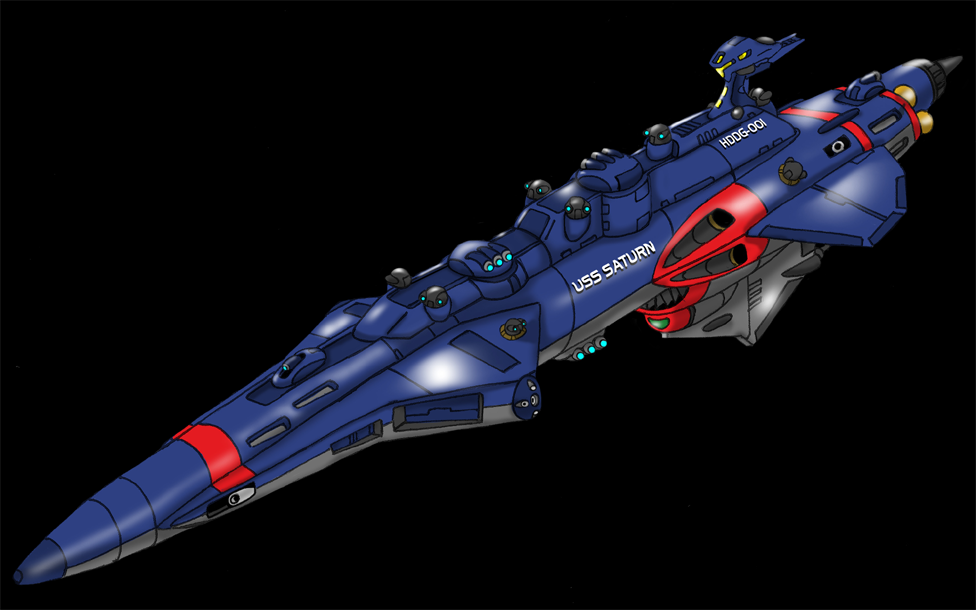 |
 |
|

GOVERNMENT:United States SpaceNavy
TYPE: Heavy Frigate
MODEL: Saturn class
DATE INTRODUCED: 2059 AD
LENGTH: 372 feet
WIDTH: 137.39 feet
HEIGHT: 115 feet
MATERIAL: Composite Alloy
POWER PLANT:
Rokwheel RNR-16000 nuclear reactor
OUTPUT: 16,000 megawatts
ARMOR TYPE: Composite Alloy
ARMOR THICKNESS: .35 inches
DISPLACEMENT: 5000 tons
CREW: 99 (5 Operator/pilot, 9 Officers, 5 Medical, 35 Gunners, 5 Technician, 5 Electrician, 5 Engineers, 20 Flight, 10 Security)
PROPULSION
PRIMARY:
1x Rocketdyne RFT-2960.5 Fusion Thruster
SPEED: 90,000 mph
AUXILLIARY:
4x Rocketdyne FT-822.4 Fusion Thrusters
SPEED: 25,000 mph each
WEAPONS:
PRIMARY (OFFENSIVE):
3x Norking LC-803 80-megawatt triple laser cannon turrets; Effective Range: 800 miles; Power Requirement: 240-megawatts; ROF: up to 6 triple blasts per minute.
SECONDARY (OFFENSIVE):
4x Norking LC-801 80-megawatt laser cannon turrets; Effective Range: 800 miles; Power Requirement: 80-megawatts; ROF: up to 6 blasts per minute.
SECONDARY (OFFENSIVE):
8x Bohing STL-02; Missile Type: MHST-01 2000-pound SMART-guided space torpedo; Effective Range: 27 miles; Payload: 4 space torpedoes each; ROF: 1 torpedo each launcher every 2 seconds (up to 30 per minute).
PRIMARY (DEFENSIVE):
8x Norking LC-402 dual 20-megawatt laser cannon turrets; Effective Range: 200 miles; Power Requirement: 40-megawatts; ROF: up to 12 blasts per minute.
PRIMARY (DEFENSIVE):
8x Norking LC-602 dual 30-megawatt laser cannon turrets; Effective Range: 300 miles; Power Requirement: 60-megawatts; ROF: up to 12 blasts per minute.
ELECTRONICS:
1x Microwave radio Communications array with a 10 AU range.
1x Laser Communications array with a 1000 AU range.
1x RADAR sensor array with a 200,000-mile range.
1x Passive EMS sensor array with a 500,000-mile range.
1x Active EMS Sensor array with a range of 50,000 miles.
1x Gravitational Control/Antigravity unit Effect: provides artificial lift,g-force compensation and enhanced maneuverability.
DEFENSE SYSTEMS:
6x Norking ND-5000 5000-megawatt nuclear dampener generators; RANGE: 50 miles; Effect: Random due to numerous variables. In general, the nuclear dampeners provided moderate to considerable resistance to energy weapons and were able to cause missile warheads to either explode or go inert within its area of effect.
Description/Overview:
The success of the initial squadron of Juno class frigates against the UN's AS-03 Luna Defense fleet near the planetoid Apophis in 2059 led Admiral Horatio Xavier to call for the immediate development of an even larger warship. He knew that the Juno frigates would permit the fledgling USSN space fleet to dominate the Earth sphere within a relatively short period of time. With this in mind, Admiral Xavier chose to have a "command" heavy frigate vessel for use with the new fleet of spacecraft. This new heavy frigate would coordinate the operations of the fleet on the front lines with the warships that would conduct the USSN campaign to retake the Earth sphere. Xavier demanded that this command-ship retain the Juno class frigate's fast, moderately armored, but more powerfully armed. From these requirements the Saturn class heavy space frigate was born.
The Saturn class was built to coordinate the USSN fleets in actual space warfare against the spacecraft of the UNSC fleet in the same manner as the old surface ocean command ships did a century before. To fill this role, the Saturn class required the same level of speed as that of the Juno and Type-59 corvette. Therefore, a large Rocketdyne RFT-2960.5 fusion thruster capable of propelling the craft at 90,000 mph. This engine was viewed as being adequate for Juno-to-Earth travel, but not enough for travel within the inner sphere of the Sol starsystem within a reasonable amount of time. Therefore, four Rocketdyne FT-822.4 Fusion Thrusters were added to the craft in order to provide an additional 100,000 mph of speed. Thus the combined speed of the Saturn was the same as that of the Juno and Type-59: that being 190,000 mph. This speed was more than enough to travel between the inner planets and the asteroid belt.
The weapons of the Saturn class heavy frigate were nearly identical to those of the Juno and quickly eclipsed the armaments of the standard frigate to become the most powerful weapons mounted on a space warship of the 2060s. Three Norking LC-803 240-megawatt triple laser cannon turrets acted as the main batteries of the heavy space frigate. These weapons allowed the frigate to go head-to-head with the anything the UN Space Corps had in their arsenal at the time. The Saturn also had four single-barrel, Norking LC-801 80-megawatt laser cannon turrets as its secondary offensive beam weaponry that allowed the Saturn the ability to fend off assault shuttles without using its main batteries. Eight dual-barrel, Norking LC-402 40-megawatt laser cannon turrets acted as the primary anti-mecha/spacefighter weapons of the warship in the same manner as the Juno frigate and the Type-59 Corvette. These dual-barrel cannon turrets were mounted in key locations along the top and bottom of the hull of the vessel in order to maximize their defensive capability. In addition to these anti-mecha/spacefighter turrets, six Norking LC-602 laser cannon turrets were added to act as anti-assault shuttle batteries. These six turrets were mounted around the top turrets and bridge of the warship on its dorsal side. The final armaments of the Saturn class were eight Bohing STL-02 heavy space torpedo tubes. Each of these tubes carried ten MHST-01 medium-range heavy space torpedoes armed with HEAP warheads (nuclear only when needed). These warheads were capable of destroying practically any UNSC spacecraft, but were intended mostly to expediate the capture of Atlas class super-heavy transport ships/space-tugs.
The Saturn was fitted with six Norking Norking ND-500 500-megawatt nuclear dampener generators in concealed hardpoints on the hull. These generators gave the craft unprecedented protection for a warship of its era, and paved the way for use of the nuclear dampening systems in future generations of USSN/EFF spacecraft. It was also fitted wtih a gravitational control unit (antigravity).
The Saturn class heavy space frigate proved to be a crowning success for the USSN fleet of the 2060s and its service record against the UNSC ensured that is was produced for over twenty years. It was an excellent fighting vessel and subsequently was built in large numbers. The production rate at the planetoid of Juno was 1 ship ever 2 months month from 2059 until 2081 when the original class was replaced by the Neptune class upgrade. Thus the total fleet of orignal Saturn class ships was 124 vessels at the end of production. Like the Juno and Type-59 before it, the Saturn class were engaged in combat almost as soon as the first vessels left the shipyards of the planetoid Juno in 2059. These warships continued fighting until the last few months of the 1st Interplanetary War and in the post-war years against space pirates afterwards. After the Earth Federal Republic began its re-armament program in 2081, the Saturn class was upgraded to the Neptune class and used as the main command-patrol vessel of the Earth Federal SpaceNavy. It should be noted that these vessels are exclusive to the EFSN and were never used by the Earth Federal Space Marine forces.